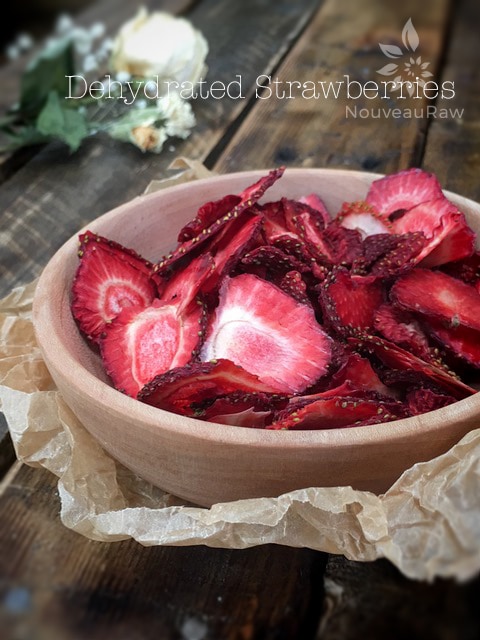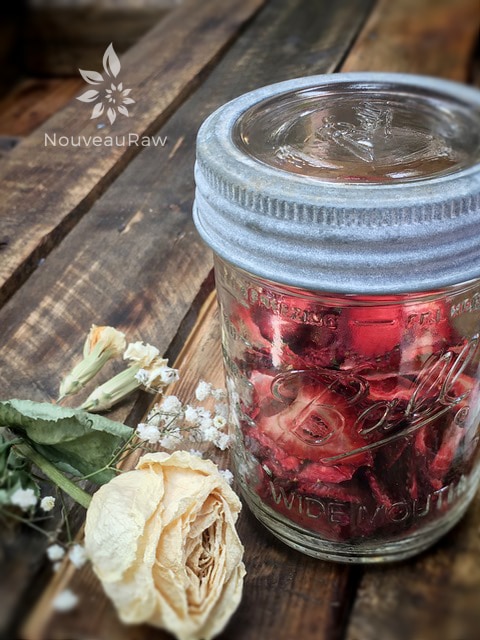Dehydrated Strawberries

 Add to favorites
Add to favorites

~ raw, dehydrated ~
Not only are dehydrated strawberries easy to make and delicious… they are nutritious. They are high in vitamin A, vitamin C, choline and vitamin K. When it comes to minerals they are high in potassium, followed by phosphorus, calcium, and magnesium. There is a whole lot going on in that little package.
There are a few important key factors that go into play when dehydrating strawberries. I mean, truthfully, there isn’t anything difficult about dehydrating fruit, but I want to share a few tips to ensure that you get successful results.
First of all, start with organic, ripe, fresh strawberries. Berries, in general, are always on the Dirty Dozen list. Meaning they are most prone to pesticides. I assume that you landed on my site because you care about what you put into your body… learning to eat organically when at all possible is something that benefits your body in the long run.
Secondly, don’t attempt to dry strawberries whole. When dehydrating at such a low temperature (to preserve the nutrients) it would take far to long to get enough moisture out of them and they would become susceptible to bacteria. At least slice them in half or smaller, depending on their size. I like to make roughly 3-4 slices per berry. They dry quick and their flavor is nice and bright.
Lastly, always use strawberries that are ripe. If they aren’t ripe enough they won’t have much flavor and if that is the case, what’s the point of even making these? Strawberries that are over-ripe would be best used for creating fruit leathers or tossing into smoothies.
Dehydrated strawberries are wonderful just as is for snacking, they can be added to granola and trail mixes, and they add wonderful flavor and color when tossed into your morning smoothie. Just be sure to drink extra water when consuming dehydrated goods since all of their water/moisture has been removed. Enjoy. Many blessings, amie sue
 Ingredients:
Ingredients:
Preparation:
Slicing the Strawberries:
- Wash, dry, and remove the crown of the strawberries.
- Slice the strawberries, cutting them the same thickness will ensure that they will all dehydrate evenly.
Drying the strawberries:
- Sun Drying ~
- This method takes 1-2 hot days (98-100%F).
- Be sure to cover the strawberries with a screen to keep insects away.
- Bring in or cover at night to keep moisture from collecting.
- To “pasteurize” sun-dried fruit in order to prevent contamination from insects, freeze for 28-72 hours.
- Oven Drying ~
- This is the fastest method and can be used if you don’t have a dehydrator. I don’t recommend this method because you will lose more of the nutrients, but start where you can.
- Set the temperature to the lowest temp, leave the door ajar; place a fan so it blows across the opening of the oven opening to carry the moisture away.
- The length of time will vary (6-15 hours) depending on how thin, thick, chewy or crisp you want them to be.
- Dehydrator ~
- Arrange strawberries on the mesh dehydrator trays.
- Place them close together but do not allow them to touch each other.
- Dehydrate at 145 degrees (F) for 1 hour, then decrease to 115 degrees for 8+/- hours.
- The dry time will depend on your machine, the amount of moisture in the strawberries and as to how dry or moist that you want them to remain.
- Allow them to cool to room temperature and store in airtight containers.
- These will keep up to 3 months in the pantry.
Conditioning the strawberries:
- This step is optional but will help you in determining if there is any moisture still left in the strawberry slices.
- Place the dried strawberries into a mason jar(s), filling it about 2/3 full. Tighten the lid and place on the counter.
- Several times a day, stop and shake the jar(s) to redistribute the strawberry pieces.
- If you notice any condensation on the sides of the jar(s), the fruit isn’t dried enough and should go back into the dehydrator for a few hours. This doesn’t need to be done if you plan on enjoying the strawberries with a week. Moisture can lead to mold and growth of bacteria.
- Once conditioned, store in airtight containers away from direct light or heat.
Culinary Explanations:
- Why do I start the dehydrator at 145 degrees (F)? Click (here) to learn the reason behind this.
- When working with fresh ingredients it is important to taste test as you build a recipe. Learn why (here).
- Don’t own a dehydrator? Learn how to use your oven (here). I do however truly believe that it is a worthwhile investment. Click (here) to learn what I use.
© AmieSue.com



 Add to favorites
Add to favorites
 Ingredients:
Ingredients: